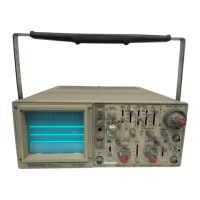OPERATION
INITIAL
STARTING
PROCEDURE
Until
you familiarize yourself
with
the use of all controls,
the
following
procedure may be used to standarize the in-
itial
setting of controls as a reference
point
and to
obtain
trace on the CRT in preparation for waveform observation.
When
using the probe(s), refer to probe's instructions and
"PROBE
COMPENSATION" listed in "APPLICATION" of
this manual.
Fig.
6
(1) NORMAL
SWEEP
DISPLAY OPERATION
1.
Turn the POWER switch @ clockwise — the power
supply
will
be turned on and the
pilot
lamp
will
light.
Set
these modes as follows;
Vertical MODE (Q) : CH1
A TRIG MODE @ : AUTO
2.
The trace
will
appear in the center of the CRT display
and can be adjusted by the CH1 y POSITION © and
POSITION @ controls.
Next,
adjust the INTENSI-
TY
(0) and, if
necessary,
the
FOCUS
@ for ease of
observation.
3. Vertical Modes
With
vertical MODE (Q) set to CH1, apply an
input
signal to the CH1 INPUT (5) jack and adjust the
VOLTS/DIV (2) control for a suitable size display of the
waveform. If the waveform does not appear in the
display, adjust the VOLTS/DIV and • POSITION controls
to bring the waveform
into
the center
portion
of the CRT
display. Operation
with
a signal applied to the CH2 IN-
PUT (9) jack and the vertical MODE set to CH2 is
similar to the above procedure.
In the ADD mode, the algebraic sum of CH1
+CH2
is
displayed. If the CH2 INV (H| switch has been engaged,
the algebraic difference of the two waveforms,
CH1 — CH2 is displayed. If
both
channels are set to the
same VOLTS/DIV, the sum or difference can be read
directly in VOLTS/DIV
from
the CRT.
The DUAL mode allows simultaneous observation of
channel 1 and channel 2 waveforms. The TRI mode
allows simultaneous viewing of channel 1
thru
channel
3
input
signals.
In the TRI mode, either the CHOP or ALT
mode applies and must be selected.
In the CHOP mode, the sweep is chopped at an approx-
imate
250 kHz
rate
and switched between CH1 and
CH2.
Note
that
in the CHOP mode of operation
with
the
SOURCE
switch set to V. MODE, the
trigger
source
becomes the chopping signal itself, making waveform
observation impossible. Use ALT mode instead in
such
cases,
or select a
trigger
SOURCE
of CH1, CH2 or CH3.
If no trace is obtainable, refer to the
following
TRIGGER-
ING procedures.
4.
After
setting the
SOURCE
switch, adjust the
LEVEL/SLOPE
control (£§). The display on the screen
will
probably be unsynchronized. Refer to TRIGGERING
procedure below for adjusting synchronization and
sweep speed to
obtain
a stable display showing the
desired number of waveform.
TRIGGERING
The
input
signal must be properly
triggered
for stable
waveform observation. TRIGGERING is possible using the
input
signal INTernally to create a
trigger
or
with
an EXTer-
nally provided signal of
timing
relationship to the observed
signal,
applying
such
a signal to the EXT TRIG INPUT jack.
The
SOURCE
switch
selects
the
input
signal
that
is to be
used
to
trigger
the sweep,
with
INT
sync
possibilities
(V.MODE, CH1, CH2, LINE) and CH3/EXT
sync
possibility.
14

